Caitlin Doughty's Blog, page 39
July 19, 2015
June 23, 2015
June 16, 2015
Deathxpert Opinion: How to Move (and Fly) a Body
I’m fascinated by post mortem travel in general. I know there are bodies in the cargo holds of commuter flights more often than people realize. But how often does that really happen and how are bodies prepared for travel over long distances?

Charon, by Order of the Good Death member Jim Doran
Who isn’t fascinated by post-mortem travel?! My resume says that I should be really well qualified to answer this question, but I’m going to tell you right now, my qualifications are thin the further flung you get. If the country you are trying to send the body to is Russia – I’m out. And if your email comes from anywhere in Africa, informing me that you are a prince and your wife just died in Seattle, and you and your newborn baby need me to ship her home if I could just give you a Western Union account… I’m out there too.
Bodies need to move because, well, we seldom die where it’s most convenient. I’ve been working on a program with the local hospice where people can choose to pre-arrange their funeral and pass away in my facility, but no one seems to be taking me up on this option. (Fair enough). So let’s look at moving a body from the place of death to their final resting place.
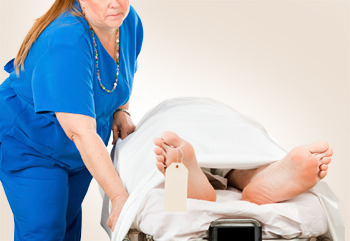
Lisa F. Young/iStock/Getty Images
After death, the family, hospital, or hospice calls the funeral home and says “Hey, you need to pick up this gentle dead person.” Funeral homes then send “removal techs” to transfer the body into our care. This is usually done with a Toyota Sienna, Honda Odyssey or some other appropriately discrete momcar. We put the deceased on a stretcher and bring them back to a refrigerated cooler, where they will rest until the arrangements have been made for transport to their final destination. You can modify this process to “bring them back and embalm them…” if you’re anywhere in the American south that believes that refrigeration is only for fish and meat and embalming is some kind of anointed God-given preservation technique.
Now that I’ve poked the embalming debate bear, I will say that it is definitely a useful technique when transporting people long distances. If we hearken back but a few decades (specifically 15 decades), people weren’t able to transport the dead any distance that couldn’t be covered in less than a day or two. Sanitation and practicality prohibited moving them more than say, 25 to 50 miles, unless you were quite wealthy. Even then, people weren’t particularly compelled to drag the dead around. Enter that wee little Civil War that killed more Americans than any other single armed conflict. It was at this time that technology, transportation and need (want) all intersected. The advent of embalming, trains, and a whole lot of dead soldiers amounted to the ability to transport people home from the front(s). And thus, the modern embalmer and death logisticians were born.

In this undated photo, Dr. Richard Burr, an embalming surgeon, prepares a body for the preservation process -Library of Congress
Today, we use the iron horse far less than we lean on the aluminum bird. As the question addresses – there are special preparations that are needed to transport the dead by plane. For a myriad of reasons, you can’t just stuff grandpa into his favorite golf bag and check him through from Scottsdale to Edmonton. Despite the common misconception, airlines do not require embalming. There is no law, policy or regulation that requires embalming– that is due, largely, to religious practices that prohibit it. Suffice it to say that embalming someone for transportation on a common carrier is the most practical and economical means by which to convey their mortal remains.
Soooo… Bodies are shipped as cargo on aircraft, and the timing, paperwork and logistics need to be coordinated like what I would imagine putting a seven year old on a plane would look like. You need to get the correct permits and authorizations, embalm them (or not), casket them, put them in an air tray, drive them to the airport, and hand them off to someone who will put them on the plane. Alright, the seven year old may not require a few of these items, but I’m willing to bet that the air tray might seem like a lovely playground to the travel weary parent – it’s a wood tray that is large enough to place a casket on and cover for safe transport through the friendly skies (imagine the best pre-made fort ever for a 7 year old. Minus the xBox.) Joking aside, here’s how it looks:
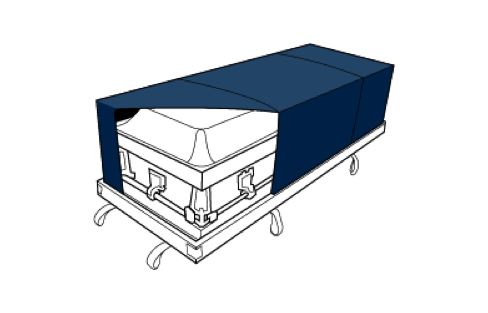
If you don’t feel like embalming your dead person, we can still get them where they need to go! The magic of rapid transportation, combined with super effective cooling pouches, we can have your dead person fit as a fiddle and ready for a visitation on the receiving end with this magical container. It is also the container that you would use if you were going to be transporting someone who has decomposition (Not that decomp transport is much of a thing):
Figure 2 – The Ziegler Case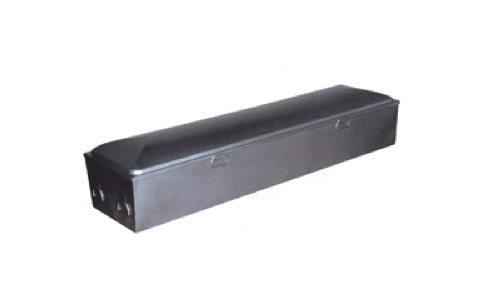 The Ziegler is a hermetically sealed metal container that is designed to keep you person fresh for the flight home. Actually, all of these things are designed to keep the airplane cabin fresh for the travelers up above. Another question that came up was “Are the dead belted in? Do they slam into the lid during turbulence?” The answer is “No, they are not belted in” and I suppose, yes, it’s possible that they would bump their nose. Usually someone who has been prepped will have a clean cloth on their face and around their collar to avoid smudging makeup or having cosmetics rub off on any of the clean fabrics around them.
The Ziegler is a hermetically sealed metal container that is designed to keep you person fresh for the flight home. Actually, all of these things are designed to keep the airplane cabin fresh for the travelers up above. Another question that came up was “Are the dead belted in? Do they slam into the lid during turbulence?” The answer is “No, they are not belted in” and I suppose, yes, it’s possible that they would bump their nose. Usually someone who has been prepped will have a clean cloth on their face and around their collar to avoid smudging makeup or having cosmetics rub off on any of the clean fabrics around them.

From Francois Robert’s Stop the Violence series
Once the body has been scanned at the airport and has passed the security checks, they are placed on the aircraft for safe passage to their final destination where the receiving funeral home will come to transfer them into their care and execute the remainder of the family’s wishes. In most cases this is a funeral with a burial to follow. Unusually, I had one family recently that was having their dad transported on a train back to his hometown for a funeral followed by a cremation. A train!
The cost of transportation is the same as any other large cargo transported on aircraft, and charged by the pound and the destination. For those of you that want specifics on how much it would cost, it would be like asking “How much will it cost me to fly to a vacation destination?” Um… “It depends”
Like most things in the funeral world, they always seem more mysterious or complicated before the explanation. I hope it hasn’t been a letdown to know that grandma’s ticket in steerage didn’t have any adventure or danger. But take solace in the fact that still alive Uncle Steve will be a cauldron of hot mess at the reception– all the best stories are with the living friends and family left behind.
June 9, 2015
May 20, 2015
A Shocking Likeness: Photography and Death in the Civil War
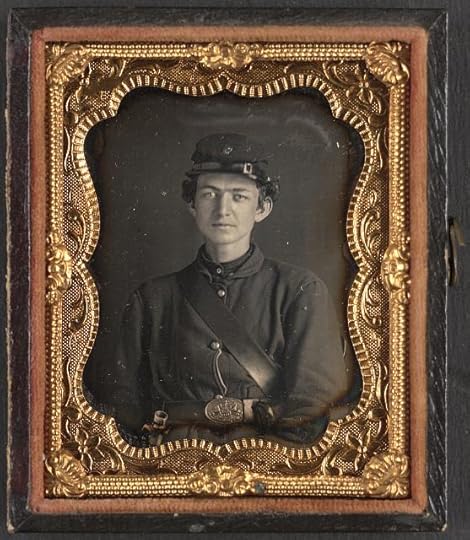
Unidentified soldier in Union uniform of the 119th Pennsylvania Volunteer Infantry, wearing the belt buckle of the Philadelphia Reserve Brigade.,c. 1861-1865, Library Of Congress
“One of our wounded, whose father brought him home to be nursed, bore to me a letter from my husband and a package from General Stuart,” writes Myrta Lockett Avary. The year is 1864 and America is divided. No one can escape the political schism that is shaping the landscape, and no one can escape the loss that accompanies it. She continues writing: “The package contained a photograph of himself that he had promised me, and a note, bright, genial, merry, like himself. That picture is hanging on my wall now. On the back is written by a hand long crumbled into dust, ‘To her who in being a devoted wife did not forget to be a true patriot.’ The eyes smile down upon us as I lift my little granddaughter up to kiss my gallant cavalier’s lips, and as she lisps his name my heart leaps to the memory of his dauntless life and death.”
The Civil War had an incredible impact on how death was managed and understood in the United States. Spanning from the spring of 1861 to the spring of 1865, the Civil War remains the largest and most gruesome war to take place on American soil. The war mounted in over 620,000 casualties, or 2% of the population; in the contemporary moment, this scale of loss translates to the entire populations of both Los Angeles and Chicago. This massive loss of life transformed the culture of the United States. With the emergence of photography in the early 19th century, photography became both wildly popular and hugely influential. Photographs, or likenesses, were taken and shared as memorials and keepsakes. Photography also brought the horrors of war into the homes of civilians. The first war to be photographed, the visual remnants of battle greatly impacted how war was both seen and understood. 
Photography was invented in 1839, and became popular rather quickly. The first type of photograph that was widely available was the daguerreotype: the photosensitive chemicals were thinly spread over a small copper plate, coated in silver. This mirrored background created a dreamy, spectral likeness that reflected the face of the viewer over the photograph itself. These small pieces were kept in folding cases, with the photograph on the left, and a small velvety cushion to safeguard the fragile photograph. These objects housed traditional portraits. For those that were wealthy enough to afford a daguerreotype or a tintype, soldiers would head to the photographic studio to have a likeness taken of them. These portraits often depicted the young man in his uniform, straight faced and looking directly at the camera. The long exposure times of the era required the subject, or sitter, of the photograph to maintain the pose for up to two minutes. Remaining still was vital, or the image would be blurry. The serious, straight face was an easier pose, not to mention the possible sobering thought that this photograph may be your last.

Dead Federal soldiers on battlefield at Gettysburg, Pennsylvania. Timothy H. O’Sullivan, photographer. Library of Congress.
The war was not only a political and cultural turning point but was also the first American war to be photographed. This marks the first time that civilians were able to see the horrors of the battlefield, of which there were many. With death constantly looming due to supply shortages, disease ridden hospitals, and dreadful weather conditions, the plight of the soldiers was frequently dire. It was common during the Civil War for writers to describe the barbarity that soldiers were faced with in periodicals and newspapers. Some illustrated publications, such as Frank Leslie’s Illustrated Newspaper or Harper’s Weekly, even took up the duty of printing artistic renderings of the war. Highly detailed ink drawings depicted the men marching though through the brush, guns in hand. The illustrators could only provide little detail, and depicted many anonymous, small figures as they traversed the rocky terrain. Such publications offered only a glimpse of major battles and day-to-day operations which many families did not see. With the war being fought by hundreds and thousands of fathers, brothers, and sons traveling far to battle, the families back home lacked first-hand accounts of the brutalities of the Civil War. The photograph could bring this home for families in ways that other media could not.

Dead Confederate soldier as he lay on the field, after the battle of the 19th May, near Mrs. Allsop’s, Pine Forest, 3 miles from Spottsylvania. Timothy H. O’Sullivan, photographer. Library of Congress.
The more gruesome photographs showed what the illustrated newspapers did not. Renowned photographers such as Alexander Gardner, Matthew Brady, and Timothy H. O’Sullivan, as well as other anonymous photographers, did not shy away from capturing the lifeless bodies that lay across the tarnished American landscape. By the 1860s, photographic technology had developed beyond the daguerreotype, and included such forms as the albumen print, which was reproducible, and printed on paper. This evolution allowed for these kinds of photographs to be easily be shared. These images were displayed in exhibitions at a photographer’s gallery, printed in books, or included with the names of the dead in newspapers. The photographs became iconic. The reality of war was finally able to seen by civilians. It not only depicted the harsh reality of the cultural and political schism that was shaping the country, but it also humanized the war in a way that drawings simply could not. The photographs were clear and still, and the faces and bodies of the fallen soldiers represented all of the fallen brothers, fathers, and sons that America had lost.
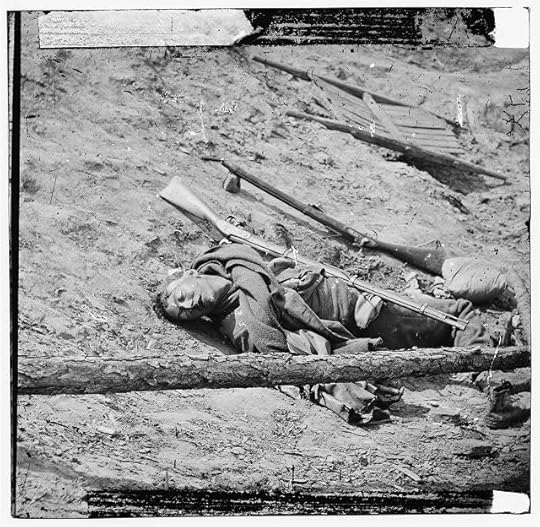
Petersburg, Va. Dead Confederate soldier with gun. Library of Congress.
These photographic depictions of fallen soldiers and their final resting places are documentation of the Civil War, but also serve as a kind of memorial object. The anonymous faces and bodies within the photographs are a testament to the service of every soldier who lost their life serving for their country. Despite the troubling nature of the images, these photographs literally mark the death of those who do not exist within the databases, lists, and cemeteries of the Civil War dead. In this way, these photographs represent the anonymous soldiers: they are given faces, and stories are given endings.
Many years later, these culturally significant photographs serve as only the beginning to a long standing tradition of war photography. In 2015, it’s impossible to imagine conflict without seeing photographs of it. The way that we imagine and talk about war is now inherently shaped by the images that are produced of it. In this way, we can see a particular version of war through the snap of a camera, on the front page of the paper, on the screens in our homes. These images serve as a reminder that history is inherently shaped by war, and those that died fighting in. Photographs of the dead show us that their loss of life was not in vain, but deeply impacts and shapes our communities, cultures, and landscapes to this day.
Order member Kelly Christian is a Chicago-based researcher, artist and staff writer for Dilettante Army Her most recent work explores postmortem and funerary photography. Kelly photographed military funerals in Maine during the height of the Iraq War and created her own new media-Daguerreotypes. She has presented her work at conferences and galleries across the country on postmortem photography, embalming, and “corpse-as-culture.”
May 12, 2015
April 21, 2015
April 6, 2015
March 26, 2015
February 24, 2015
Talking To Your Parents About Death
Caitlin Doughty's Blog
- Caitlin Doughty's profile
- 8410 followers



